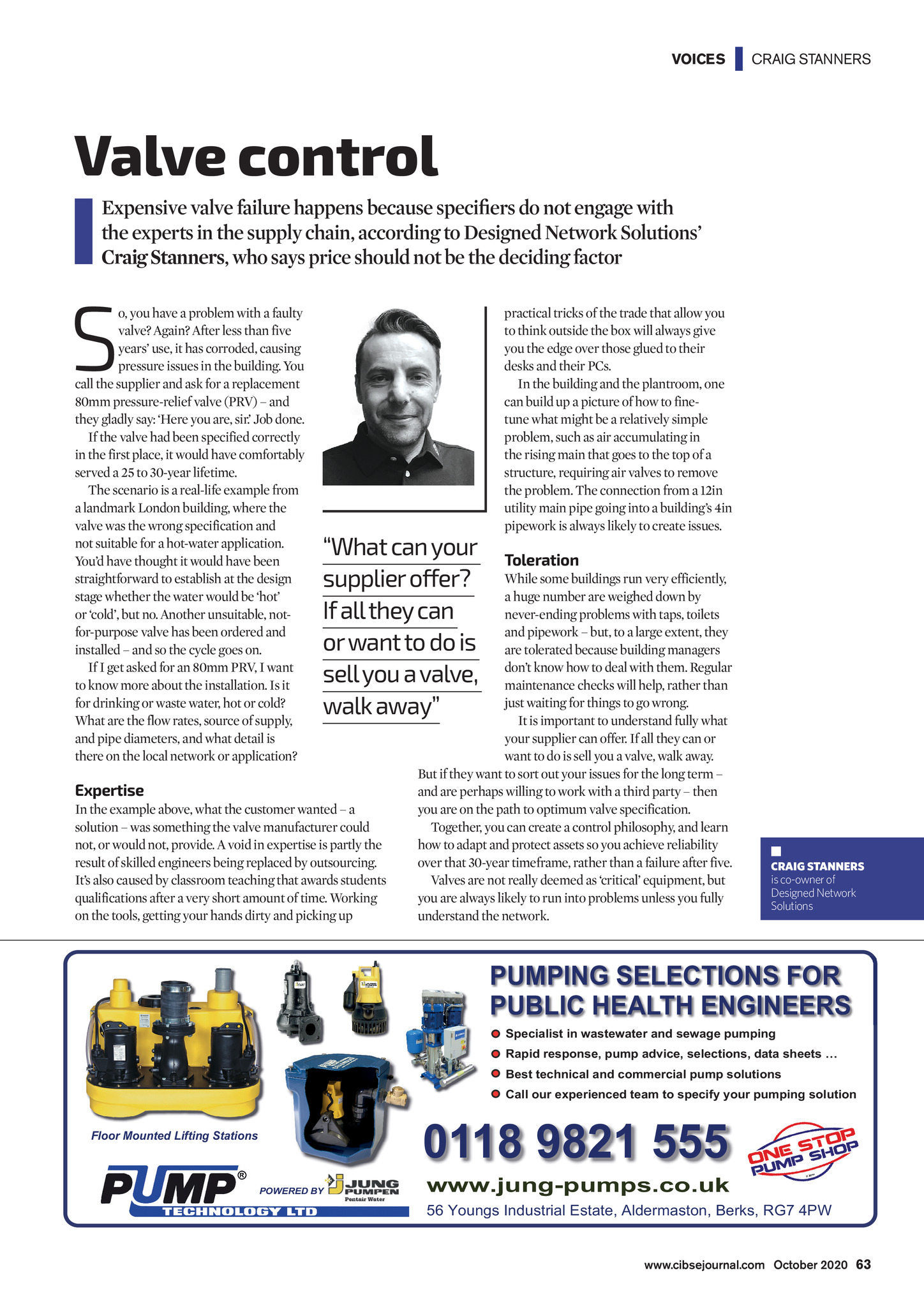


VOICES | CRAIG STANNERS Valve control Expensive valve failure happens because speciers do not engage with the experts in the supply chain, according to Designed Network Solutions Craig Stanners, who says price should not be the deciding factor S o, you have a problem with a faulty valve? Again? After less than five years use, it has corroded, causing pressure issues in the building. You call the supplier and ask for a replacement 80mm pressure-relief valve (PRV) and they gladly say: Here you are, sir. Job done. If the valve had been specified correctly in the first place, it would have comfortably served a 25 to 30-year lifetime. The scenario is a real-life example from a landmark London building, where the valve was the wrong specification and not suitable for a hot-water application. Youd have thought it would have been straightforward to establish at the design stage whether the water would be hot or cold, but no. Another unsuitable, notfor-purpose valve has been ordered and installed and so the cycle goes on. If I get asked for an 80mm PRV, I want to know more about the installation. Is it for drinking or waste water, hot or cold? What are the flow rates, source of supply, and pipe diameters, and what detail is there on the local network or application? What can your supplier offer? If all they can or want to do is sell you a valve, walk away Expertise In the example above, what the customer wanted a solution was something the valve manufacturer could not, or would not, provide. A void in expertise is partly the result of skilled engineers being replaced by outsourcing. Its also caused by classroom teaching that awards students qualifications after a very short amount of time. Working on the tools, getting your hands dirty and picking up practical tricks of the trade that allow you to think outside the box will always give you the edge over those glued to their desks and their PCs. In the building and the plantroom, one can build up a picture of how to finetune what might be a relatively simple problem, such as air accumulating in the rising main that goes to the top of a structure, requiring air valves to remove the problem. The connection from a 12in utility main pipe going into a buildings 4in pipework is always likely to create issues. Toleration While some buildings run very efficiently, a huge number are weighed down by never-ending problems with taps, toilets and pipework but, to a large extent, they are tolerated because building managers dont know how to deal with them. Regular maintenance checks will help, rather than just waiting for things to go wrong. It is important to understand fully what your supplier can offer. If all they can or want to do is sell you a valve, walk away. But if they want to sort out your issues for the long term and are perhaps willing to work with a third party then you are on the path to optimum valve specification. Together, you can create a control philosophy, and learn how to adapt and protect assets so you achieve reliability over that 30-year timeframe, rather than a failure after five. Valves are not really deemed as critical equipment, but you are always likely to run into problems unless you fully understand the network. CRAIG STANNERS is co-owner of Designed Network Solutions 3803,1*6(/(&7,216)25 38%/,&+($/7+(1*,1((56 6SHFLDOLVWLQZDVWHZDWHUDQGVHZDJHSXPSLQJ 5DSLGUHVSRQVHSXPSDGYLFHVHOHFWLRQVGDWDVKHHWV %HVWWHFKQLFDODQGFRPPHUFLDOSXPSVROXWLRQV &DOORXUH[SHULHQFHGWHDPWRVSHFLI\\RXUSXPSLQJVROXWLRQ )ORRU0RXQWHG/LIWLQJ6WDWLRQV 32:(5( %< ZZZMXQJSXPSVFRXN